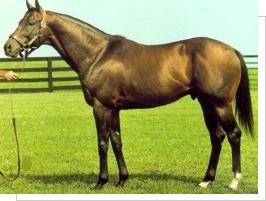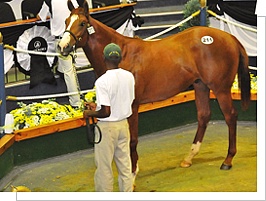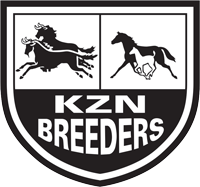
The purchase of a yearling, as exciting as it is, should be done with the assistance of an experienced person who has an “eye” for a horse. The “frame” and how a horse is put together are referred to as conformation, which if incorrect can result in unsoundness and other issues. Remember, you are purchasing an athlete.
Born in 1974, Alleged(USA) – By Hoist The Flag out of Princess Pout by Prince John (pictured), was considered one of the most perfectly put together horses. Dr Michael Osbourne, a world authority on thoroughbred conformation, said of the two-time winner of the Arc de Triomphe, “…this animal is perhaps the most perfectly constructed thoroughbred I’ve ever studied…”
Here are some basics about what to look for when buying a young horse:
- The horse should have a presence, a specialness that makes them stand out from the others, and he must look the part of what is expected of him.
- His head should be proportionate to his body, with well-defined features, and a large round honest eye. His forehead should broad and flat, and if it’s a colt, a good strong jaw would be preferable. His ears should be of a medium size, and carried alertly. Short ears tend to look common. His nostrils should be large (remember the importance of a horse having room to breath so to speak – horses don’t breath through their mouths) with thin lips, and if his mouth is opened, his teeth incisors on top and bottom jaw should be matched, and no under or over bite – these horses tend to struggle with their condition if this is the case. You should be able to fit a fist underneath the horses jaw, to ensure good room for the larynx and to breath efficiently. The horse should not be too thick through the jowl, (where the head meets the neck) as this will impede his movement of head carriage, and interfere with respiration.
- The neck should be proportionate to his body, and not too short or thick, he should have a reasonable crest but not too heavy. It is undesirable to have a thick heavy neck in a racehorse. The neck should be long and lean, and is referred to as “a good length of rein”. He shouldn’t have built up too much heavy muscle on the underside of his neck as again, this could affect his head carriage and is generally formed from bad habits. His trachea, and jugular groove and on the underside of either side of the neck should be clearly defined.
- The withers should be defined, but not too high and not too low, although in Thoroughbreds, they tend to be more prominent then in other breeds of horses.
- The shoulders should be of ample length and sloping, and is an integral part of the horses movement. The muscle on the shoulder should be well developed and not too lean. Full range of motion of the shoulder cannot be attained unless the horse has a good length of back to accommodate its obliqueness. Upright shoulders tend to make a horses’ stride short and choppy, and cause more concussion on the front legs and hooves then need be. The slope of the shoulder should match the angle of the horses’ pasterns.
- The forearm should be of a good length and proportionate to the shoulder, and well-muscled. The elbow should stand clear, and in fact, if you can fit a hand between the elbow and the girth of the horse, this indicates a horse that has the ability to move freely and use his shoulders to the full. The elbow should not turn in or out, as this will result in the feet matching the angle which is undesirable and can produce lameness in the lower part of the leg due to strain.
- The knees should be large, flat, well set on, and straight, cool to the touch and flat in front. Any angle will cause unsoundness eventually, under strain. Make sure the size of the knee is in proportion to the size of a horses body. Small knees in a horse that is well built on top will be a problem. In the young horse, the knees might still be “open”, and these will close as the horse matures. The knee should not be over the canon bone – “over at the knee”, nor should it be behind – “calf knees” -as these faults will cause unsoundness and undue strain on the tendons. The leg from the front and side view should be straight. The canon bone should be short, to absorb concussion efficiently, and it should not appear too light. It needs a good measurement of bone below the knee and shouldn’t appear to be light. The tendons should be clean with no bumps, cool, and clearly defined. When viewed from the front, the cannon, fetlock and pasterns must be in a straight line. The fetlocks should be wide, thick and free of blemishes. The pasterns should slope and maintain the same slope to the hoof, without a break in the axis. Long pasterns will create strain on the tendons and are generally weak. Short upright pasterns will cause a shortened stride and more concussion in the leg. The feet should be straight, and not toe in, as it could cause the horse to knock himself when in high speed work, and cause splints under the knees from weakness. He shouldn’t toe out either, as this tends to cause dishing. The hooves. This is the most important part of the animal, and the old saying “no hoof – no horse” could not be more true. Feet must be of a similar size, and not too small for the proportion of the horses body, neither should they be too flat. The horse should have a strong, deep, wide heel and a well-developed frog. The foot should stand level, and be free from rings or grooves, and not show any signs of contracting in the quarters. The angle of the slope of the hoof wall with the pastern should be the same, and should not be broken.
- The chest should be deep and full, the ribs long and well sprung, with a deep girth for maximum lung capacity. There should be a handbreadth between the last rib and the point of the hip bone. A narrow rib cage is undesirable and reduces the capacity for the chest and heart. If the chest is too narrow, it will appear as if the forelegs emerge from the body too close together, and look as if the legs are coming out the same hole! If the chest is too wide, he will tend to paddle with his forelegs and waste his forward action.
- Whilst the ideal horse should have a short, strong back, in buying a racehorse it is desirable that it should have some length, without having shortness of the loins. A horse with long loins will give the impression of weakness, and have too much length behind the saddle. The conformation of the back should have a slight dip, but never exaggerated as this is a weakness, neither should it be ‘roached’ – where there is an upward curve of the back and loin, as the horse’s movement will be restricted. The belly of the horse should be proportionate, neither too big, or too light indicating that the horse will struggle to maintain condition.
- The croup is an important part of the make-up of the horse – this is the part between the loins and the tail of the horse. The pelvis and sacrum are involved in its formation. A horizontal croup is ideal with the tail well set on, but bear in mind when buying a young horse, at times in their growth they will be dubbed “croup high” – when their croup appears higher than their withers, this indicates the horse is still growing. When the withers and croup even out, generally they have completed their growth.
- The hind legs are the horses propellers and are held by a series of large, powerful muscles. The horse should be well muscled over his hindquarters, and if not level, almost apple in shape when viewed from behind. The thighs should be long, muscled and well let down. The second thigh, (above the hocks) should be well muscled and not too long. The hocks is the most important joint in the process of propulsion, and sadly an example of this being a fault going wrong was the grey, Rabiya, put down in the Durban July a few years ago. The hock needs to be well developed and properly positioned, for maximum range of motion and soundness. It should appear to be well supported, no tie in below. Sickle hocks, a fault where the cannon bone is angled in such a way that the hock appears to be the weak point. It leads to excessive strain of the hock and strain on the tendons. Cow hocks, where the point of the hock is angled toward each other, cause the toes to splay outwards and waste of energy and movement take place, because they move outwards and not in a straight line. Bowed hocks are equally unwanted, as the horse will have a “twisting” action with their feet when they walk, and tend to develop problems with their hocks as their work progresses, and they wear their shoes unevenly. With a good hock, the cannon bone will appear vertical to the ground.
- It is important to watch the horse walk freely, without the handler holding on too tightly to his head. He should march with his front legs, the toe well extended, and his feet should land straight and level, with no toeing in or out. A horse that lands with his foot on the heels will not remain sound. The hind legs should follow with plenty of impulsion and swing in the hips, and the hind foot print should land well in front of the foreleg hoof print left behind. This will indicate the horse has good and free movement, however his movement should be low and sweeping, carrying the hind leg well forward under himself. His head should not dip or be inclined to a front limb when he walks. When looking at the horse from the front, imagine a line drawn perpendicular, through the centre of each leg, and both halves of this line should appear even and straight.A horse that is more likely to be a sprinter from his pedigree, will tend to have a stockier build, with heavier muscle over his shoulders and hindquarters, and he will have more of a tendency to be short-coupled.
The horse that is more likely to be a stayer will tend to be more rangy, carrying more lean muscle, and be a bit longer in the back.
Take note of human athletes, the sprinters such as Usain Bolt for instance, are built differently to the long-distance marathon runners (Bruce Fordyce for example), and same applies to purchasing a horse!

Purchasing at Auction
Public Auction
Auction sales offer the widest selection and often assure fair market values for horses. Champion racehorses can come from humble backgrounds, but you are more likely to be found at major sales where yearlings are selected on pedigree and conformation and are the “cream of the crop”. A schedule of upcoming sales is available on this website here.
Auction Procedures
Prior to the Sale:
1. Complete a buyers card application for the sale.
2. Establish credit facilities with the sales company.
3. Review conditions of the sale.
4. Meet your consultants (agent and/or trainer) to select your horses.
5. Devise a first look list and subsequent short list. The short list will be dependent on the conformation inspection of each horse.
6. Assign responsibilities
7. Bidding arrangements
8. Insurance
9. Post-sale arrangementsDuring the Sale
1. All horses on your preliminary list should be inspected.
2. Inspect your final choices several times. Do not be afraid to go back for a second and third look.
3. You may want to have a veterinarian perform a pre-purchase examination and view radiographs (should these be available).
4. Bidding – do not permit yourself to get carried away when bidding.
5. Follow your initial plan and stay within your identified budget.
6. Bid only on horses on your short-list, exercise control and stay within the pre-determined price limit for the horse.
Post-sales Procedure
Payment
Payment for the purchases should be consistent with the arrangements made with the sales company. Upon payment, buyers will be given a stable release and at a later stage the National Horseracing Authority change of ownership certificate from the sales company. Successful bidders must make the necessary arrangements for the transport from the sales ground and the board and care of their purchase/s.
Insuring your horse
Insuring your purchase is optional and a number of factors have to be taken into account. Racehorses – move faster and train more vigorously than any other athlete and therefore at a greater potential risk. As such are you happy to carry the risk of your investment yourself? Selecting a broker is an important decision. Choose a professional, registered bloodstock insurance broker. Once you have taken the decision to insure, you are obliged to ensure that your trainer keeps your broker informed of any illness or injury suffered by the horses and to notify them of any operations e.g. gelding.

